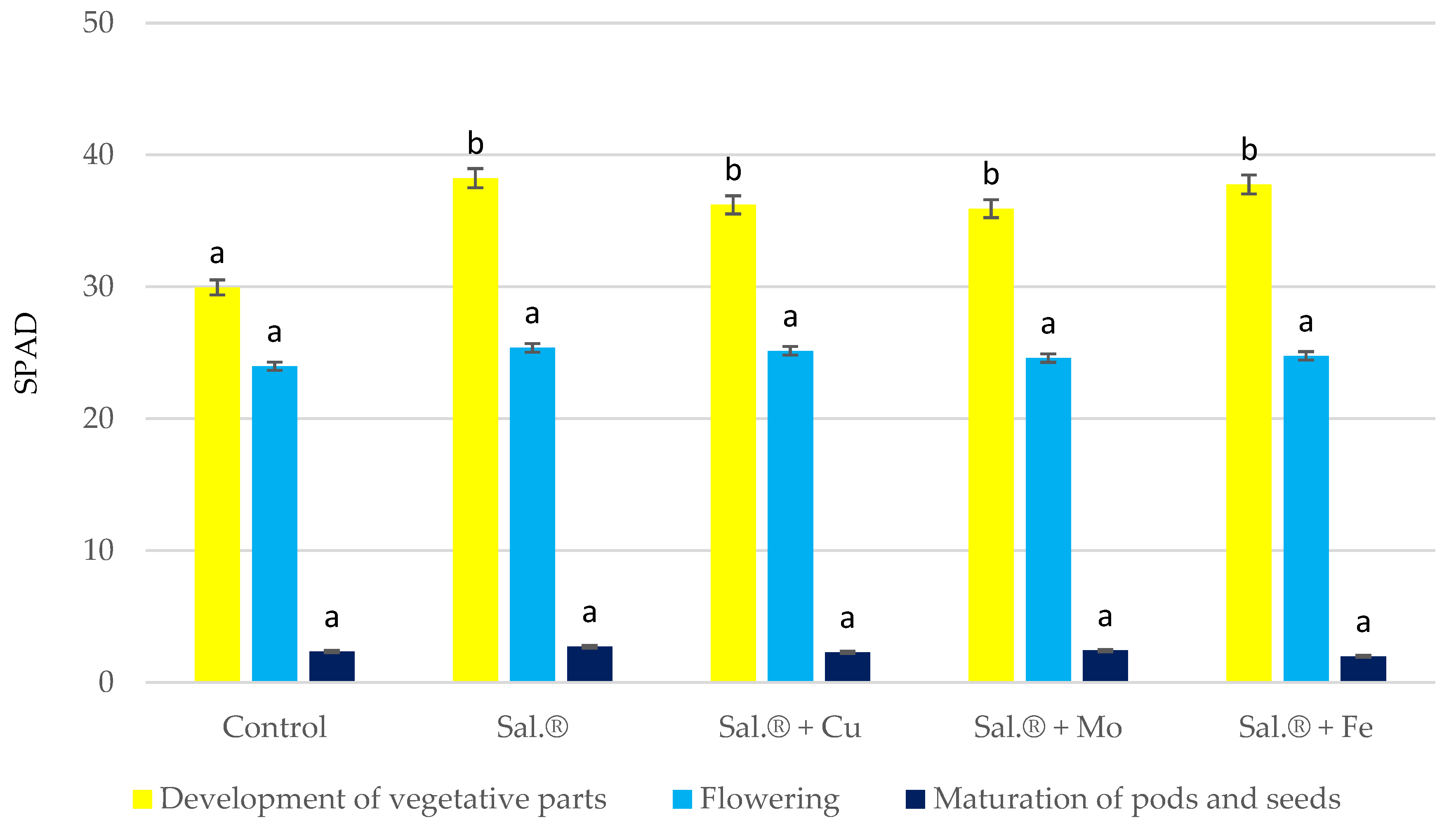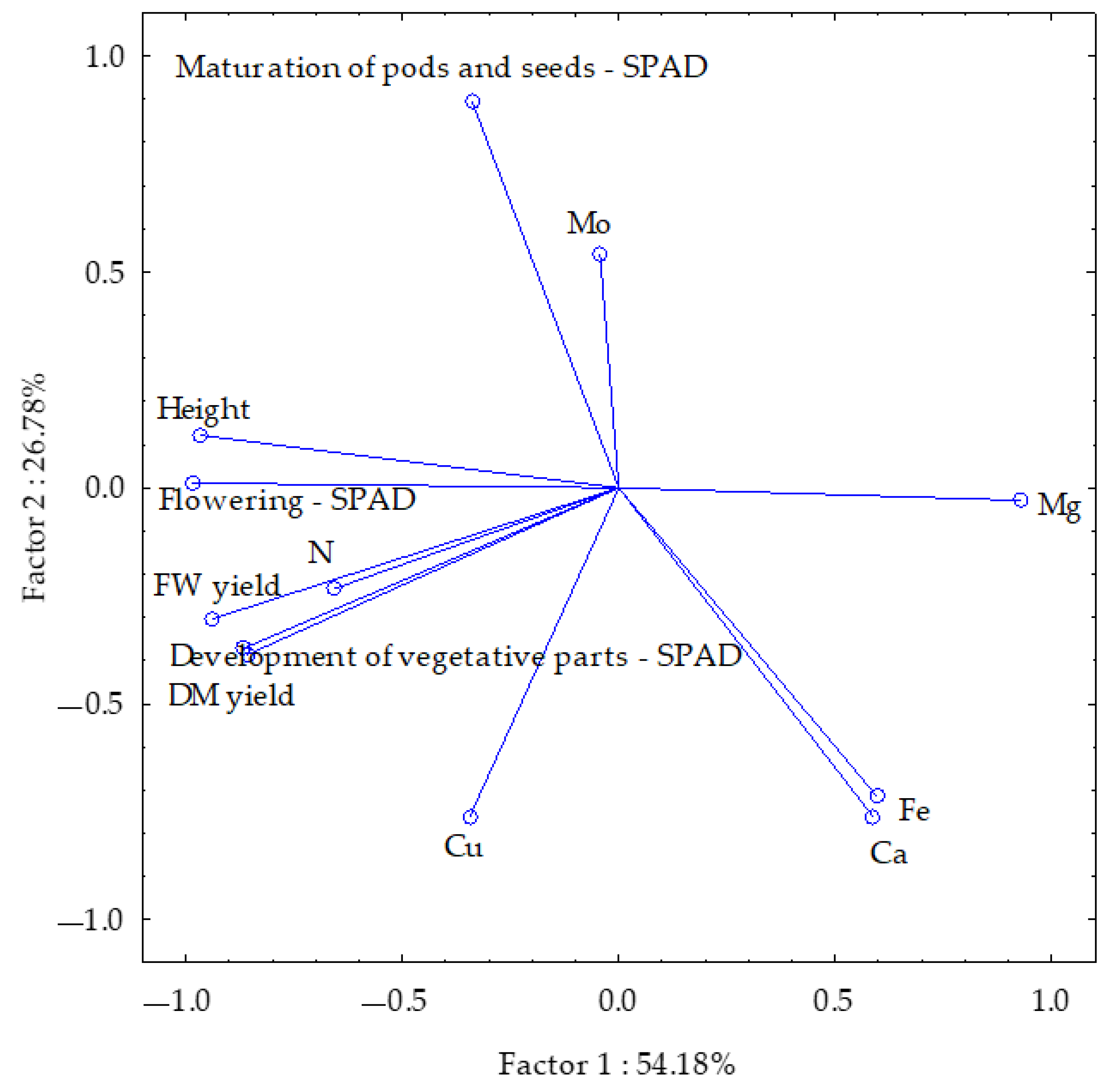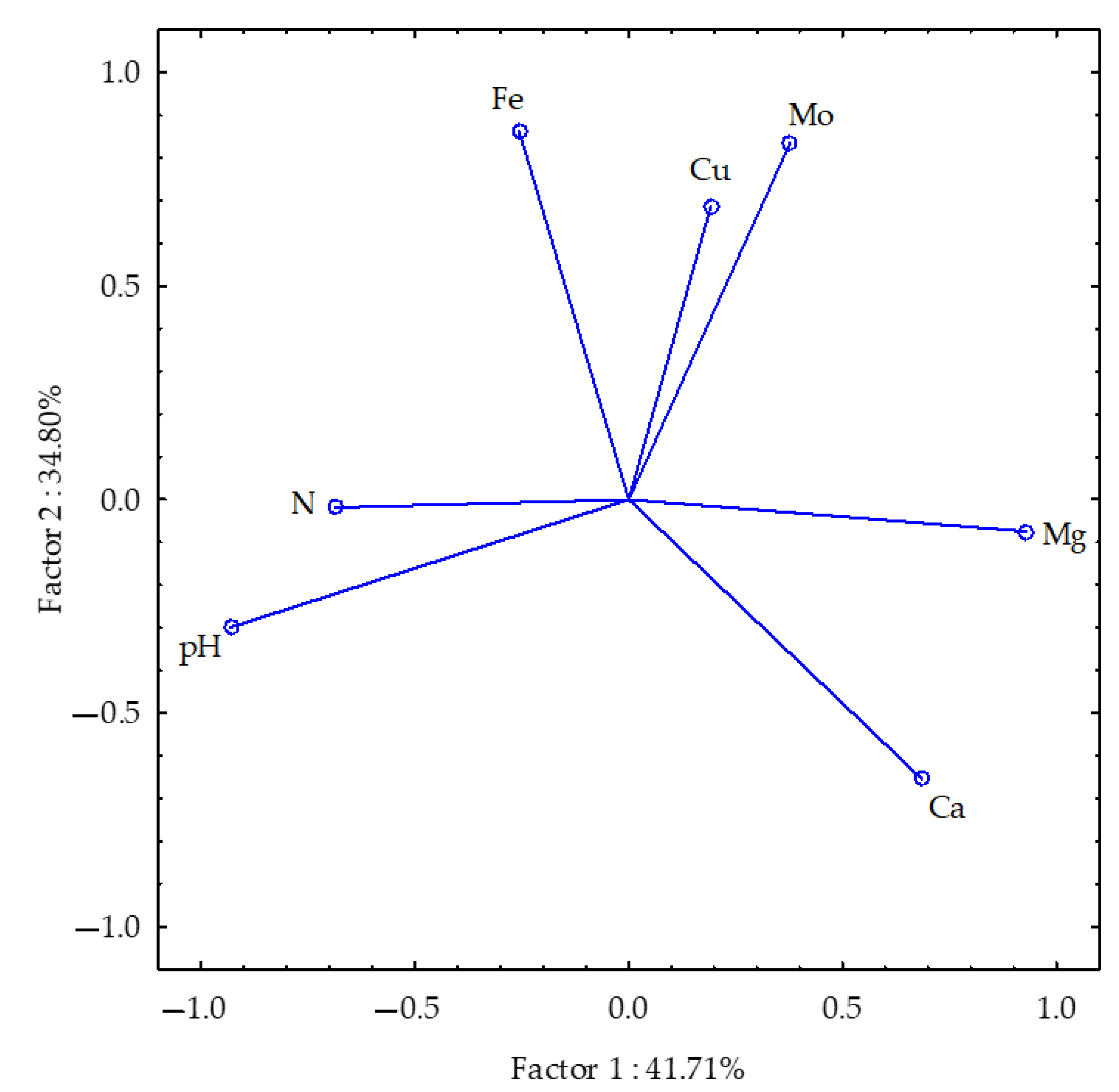Innovative Materials as Micronutrient Carriers in Soybean Cultivation
Abstract
1. Introduction
2. Materials and Methods
2.1. Methodological Considerations
2.2. Laboratory and Statistical Analysis Methods
3. Results
3.1. Plants
3.1.1. SPAD Index
3.1.2. Plant Biometric Properties
3.1.3. Crop Yield
3.1.4. Macroelements
3.1.5. Microelements
3.2. Soil Properties
3.2.1. pH
3.2.2. Macroelements
3.2.3. Microelements
3.3. PCA Analysis
3.3.1. Soybean Seeds
3.3.2. Other Above-Ground Parts of Soybean
3.3.3. Soil After Soybean Harvest
4. Discussion
5. Conclusions
6. Recommendations and Future Actions
Author Contributions
Funding
Institutional Review Board Statement
Informed Consent Statement
Data Availability Statement
Conflicts of Interest
References
- Sekhon, B.S. Chelates for micronutrient nutrition among crops. Reson 2003, 8, 46–53. [Google Scholar] [CrossRef]
- Schenkeveld, W.D.C.; Temminghoff, E.J.M.; Reichwein, A.M.; van Riemsdijk, W.H. FeEDDHA-facilitated Fe uptake in relation to the behaviour of FeEDDHA components in the soil-plant system as a function of time and dosage. Plant Soil 2010, 332, 69–85. [Google Scholar] [CrossRef]
- Barczyk, K.; Jasiak-Małota, K.; Brodowska, M. Efficiency of using aminochelate fertilizers in plant nutrition. Przem. Chem. 2024, 103, 271–276. [Google Scholar] [CrossRef]
- Klem-Marciniak, E.; Huculak-Mączka, M.; Marecka, K.; Hoffmann, K.; Hoffmann, J. Chemical stability of the fertilizer chelates Fe-EDDHA and Fe-EDDHSA over time. Molecules 2021, 26, 1933. [Google Scholar] [CrossRef]
- Mahmoud, A.W.M.; Ayad, A.A.; Abdel-Aziz, H.S.M.; Williams, L.L.; El-Shazoly, R.M.; Abdel-Wahab, A.; Abdeldaym, E.A. Foliar application of different iron sources improves morpho-physiological traits and nutritional quality of broad bean grown in sandy soil. Plants 2022, 11, 2599. [Google Scholar] [CrossRef]
- Bindraban, P.S.; Dimkpa, C.; Nagarajan, L.; Roy, A.; Rabbinge, R. Revisiting fertilisers and fertilization strategies for improved nutrient uptake by plants. Biol. Fertil. Soils 2015, 51, 897–911. [Google Scholar] [CrossRef]
- Shivay, Y.S.; Prasad, R.; Kaur, R.; Pal, M. Relative efficiency of zinc sulphate and chelated zinc on zinc biofortification of rice grains and zinc use-efficiency in basmati rice. Proc. Natl. Acad. Sci. India Sect. B Boil. Sci. 2015, 86, 973–984. [Google Scholar] [CrossRef]
- Grzesik, R.; Pankalla, E.; Kuźnik, N. Coating of calcium ammonium nitrate fertilizers with model chelates. Przem. Chem. 2022, 101, 810–814. [Google Scholar] [CrossRef]
- Sinegani, A.A.S.; Tahmasbian, I.; Sinegani, M. Chelating agents and heavy metal phytoextraction. In Heavy Metal Contamination of Soils: Monitoring and Remediation; Springer: Berlin/Heidelberg, Germany, 2015; pp. 367–393. [Google Scholar]
- Clemens, D.F.; Whitehurst, B.M.; Whitehurst, G.B. Chelates in agriculture. Nutr. Cycl. Agroecosyst. 1990, 25, 127–131. [Google Scholar] [CrossRef]
- Saridis, G.; Chorianopoulou, S.N.; Ventouris, Y.E.; Sigalas, P.P.; Bouranis, D.L. An exploration of the roles of ferric iron chelation-strategy components in the leaves and roots of maize plants. Plants 2019, 8, 133. [Google Scholar] [CrossRef]
- Brodowska, M.S.; Wyszkowski, M.; Grzesik, R. New fertilisers with innovative chelates in wheat cultivation. Agronomy 2024, 14, 1832. [Google Scholar] [CrossRef]
- Specht, J.E.; Diers, B.W.; Nelson, R.L.; de Toledo, J.F.F.; Torrion, J.A.; Grassini, P. Soybean. In Yield Gains in Major U.S. Field; American Society of Agronomy: Madison, WI, USA; Crop Science Society of America: Madison, WI, USA; Soil Science Society of America, US: Madison, WI, USA, 2014; pp. 311–355. [Google Scholar] [CrossRef]
- Bagale, S. Nutrient Management for soybean crops. Internat. J. Agron. 2021, 2021, 10. [Google Scholar] [CrossRef]
- IUSS Working Group WRB. World Reference Base for Soil Resources 2014; International Soil Classification System for Naming Soils and Creating Legends for Soil Maps; Update 2015. In World Soil Resources Reports No. 106; FAO: Rome, Italy, 2015; p. 182. Available online: https://www.fao.org/3/i3794en/I3794en.pdf (accessed on 28 February 2025).
- Salmag® Specification. Available online: https://grupaazoty.com/upload/1/files/2024/nawozy/Specification%20Salmag%205.02.2024_EN.pdf (accessed on 5 March 2025).
- Patent No. 242478. Sposób Otrzymywania Biodegradowalnych Mikroelementowych Komponentów Nawozowych Oraz Biodegradowalne, Mikroelementowe Komponenty Nawozowe. 2022. Available online: https://ewyszukiwarka.pue.uprp.gov.pl/search/pwp-details/P.435383 (accessed on 8 January 2025).
- ISO 11261; Soil Quality—Determination of Total Nitrogen—Modified Kjeldahl Method. International Organization for Standardization: Geneva, Switzerland, 1995.
- Ostrowska, A.; Gawliński, S.; Szczubiałka, Z. Methods of Analysis and Assessment of Soil and Plants Properties, 1st ed.; Institute of Environmental Protection: Warsaw, Poland, 1991; pp. 1–334. [Google Scholar]
- ISO 10390; Soil Quality—Determination of Ph. International Organization for Standardization: Geneva, Switzerland, 2005.
- PN-R-04032; Soil and Mineral Materials—Sampling and Determination of Particle Size Distribution. Polish Committee for Standardization: Warszawa, Poland, 1998.
- Statistica (Data Analysis Software System), Version 13.3; TIBCO Software Inc.: Palo Alto, CA, USA, 2017.
- Xiao, J.; Guo, G.; Jeong, B.R. Iron supplement-enhanced growth and development of Hydrangea macrophylla in vitro under normal nd high pH. Cells 2021, 10, 3151. [Google Scholar] [CrossRef]
- He, Z.L.; Yang, X.E.; Stoffella, P.J. Trace elements in agroecosystems and impacts on the environment. J. Trace Elem. Med. Biol. 2005, 19, 125–140. [Google Scholar] [CrossRef]
- Kabata-Pendias, A.; Szteke, B. Trace Elements in Soils and Plants, 1st ed.; CRC Press: Boca Raton, FL, USA; Taylor and Francis Group: Boca Raton, FL, USA, 2015; p. 468. [Google Scholar] [CrossRef]
- Grześkowiak, A. Vademecum on Fertilisation or Basic and Practical Information on Sustainable Fertilisation; Grupa Azoty Zakłady Chemiczne “Police” S.A., Police, 2016, 1–112. Available online: https://polifoska.pl/images/pliki/vademecum-nawozenia.pdf (accessed on 5 January 2025).
- Alloway, B.J. Micronutrient Deficiencies in Global Crop Production; Springer Science & Business Media B.V.: Berlin, Germany, 2008. [Google Scholar]
- Meena, V.S.; Meena, S.K.; Verma, J.P.; Kumar, A.; Aeron, A.; Mishra, P.K.; Bisht, J.K.; Pattanayak, A.; Naveed, M.; Dotaniya, M.L. Plant beneficial rhizospheric microorganism (PBRM) strategies to improve nutrients use efficiency: A review. Ecol. Eng. 2017, 107, 8–32. [Google Scholar] [CrossRef]
- Mimmo, T.; Del Buono, D.; Terzano, R.; Tomasi, N.; Vigani, G.; Crecchio, C.; Pinton, R.; Zocchi, G.; Cesco, S. Rhizospheric organic compounds in the soil-microorganism-plant system: Their role in iron availability. Eur. J. Soil Sci. 2014, 65, 629–642. [Google Scholar] [CrossRef]
- Ye, L.; Li, L.; Wang, L.; Wang, S.; Li, S.; Du, J.; Shou, H. MPK3/MPK6 are involved in iron deficiency-induced ethylene production in Arabidopsis. Front. Plant Sci. 2015, 6, 953. [Google Scholar] [CrossRef]
- Goli, M.; Pande, M.; Bellaloui, N. Effects of chelating agents on protein, oil, fatty acids, and minerals in soybean seed. Agricult. Sci. 2012, 3, 517–523. [Google Scholar] [CrossRef][Green Version]
- Santos, R.L.; Freire, F.J.; Oliveira, E.C.A.; Freire, M.B.G.S.; West, J.B.; Barbosa, J.A.; Moura, M.J.; Bezerra, P.C. Nitrate reductase activity and nitrogen and biomass accumulation in sugarcane under molybdenum and nitrogen fertilization. Rev. Bras. Cienc. Solo 2019, 43, e0180171. Available online: https://www.scielo.br/j/rbcs/a/fBJvV479nf5PpjtTYd4kxcL/?format=pdf&lang=en (accessed on 26 February 2025). [CrossRef]
- Tallkvist, J.; Oskarsson, A. Molybdenum. In Handbook on the Toxicology of Metals, 4th ed.; Academic Press: Cambridge, MA, USA, 2016; Chapter 47; pp. 1077–1089. [Google Scholar] [CrossRef]
- Muñoz-Márquez, E.; Soto-Parra, J.M.; Noperi-Mosqueda, L.C.; Sánchez, E. Application of molybdenum nanofertilizer on the nitrogen use efficiency, growth and yield in green beans. Agronomy 2022, 12, 3163. [Google Scholar] [CrossRef]
- Carlim, E.L.; Meert, L.; Reis, B.; Alleman, L.E. Fertilization with nickel and molybdenum in soybean: Effect on agronomic characteristics and grain quality. Terra Latinoam. 2019, 37, 217–222. [Google Scholar] [CrossRef]
- Surányi, S.; Izsáki, Z. Plant analysis application for environmentally friendly fertilization of winter barley (Hordeum vulgare L.). Appl. Ecol. Environ. Res. 2018, 16, 5213–5226. [Google Scholar] [CrossRef]
- Wyszkowski, M.; Kordala, N.; Brodowska, M. Role of humic acids-based fertilisers and nitrogen fertilisers in the regulation of the macroelement content in maize biomass. J. Elem. 2023, 28, 1289–1309. [Google Scholar] [CrossRef]
- Czarnecki, S.; Düring, R.A. Influence of long-term mineral fertilization on metal contents and properties of soil samples taken from different locations in Hesse, Germany. Soil 2015, 1, 23–33. [Google Scholar] [CrossRef]
- Brodowska, M.S.; Wyszkowski, M.; Karsznia, M. Application of urea and ammonium nitrate solution with potassium thiosulfate as a factor determining macroelement contents in plants. Agronomy 2024, 14, 1097. [Google Scholar] [CrossRef]
- Miner, G.L.; Delgado, J.A.; Ippolito, J.A.; Barbarick, K.A.; Stewart, C.E.; Manter, D.K.; Del Grosso, S.J.; Halvorson, A.D.; Floyd, B.A.; D’Adamo, R. Influence of long-term nitrogen fertilization on crop and soil micronutrients in a no-till maize cropping system. Field Crops Res. 2018, 228, 170–182. [Google Scholar] [CrossRef]
- Schoffer, J.T.; Sauve, S.; Neaman, A.; Ginocchio, R. Role of leaf litter on the incorporation of copper-containing pesticides into soils under fruit production: A review. J. Soil Sci. Plant Nutr. 2020, 10, 990–1000. [Google Scholar] [CrossRef]
- Adhikari, L.; Missaoui, A.M. Nodulation response to molybdenum supplementation in alfalfa and its correlation with root and shoot growth in low pH soil. J. Plant Nutr. 2017, 40, 2290–2302. [Google Scholar] [CrossRef]
- Ge, X.X.; Vaccaro, B.J.; Thorgersen, M.P.; Poole, F.L.; Majumder, E.L.; Zane, G.M.; De Leon, K.B.; Lancaster, W.A.; Moon, J.W.; Paradis, C.J.; et al. Iron- and aluminium-induced depletion of molybdenum in acidic environments impedes the nitrogen cycle. Environ. Microbiol. 2019, 21, 152–163. [Google Scholar] [CrossRef]
- Kwiatkowski, C.A.; Harasim, E. Chemical properties of soil in four-field crop rotations under organic and conventional farming systems. Agronomy 2020, 10, 1045. [Google Scholar] [CrossRef]





| Parameter | Content |
|---|---|
| Granulometric composition (%) | |
| Sand (2.0–0.05 mm) | 77.55 |
| Dust (0.05–0.002 mm) | 19.95 |
| Clay (<0.002 mm) | 2.50 |
| pH value in 1 M KCl dm−3 | 5.85 |
| Total macroelements (g kg−1 DM): | |
| Total organic carbon (TOC) | 3.104 |
| N | 1.120 |
| Ca | 5.481 |
| Mg | 2.229 |
| Available macroelements (mg kg−1 DM): | |
| P | 22.16 |
| K | 145.0 |
| Total microelements (mg kg−1 DM): | |
| Cu | 7.829 |
| Mo | 0.959 |
| Fe | 10,108 |
| Fertiliser | Yield FM | Yield DM | N | Ca | Mg | Cu | Mo | Fe |
|---|---|---|---|---|---|---|---|---|
| g pot−1 | Content in g kg−1 DM | Content in mg kg−1 DM | ||||||
| Seeds | ||||||||
| Control | 5.35 ± 0.12 a | 3.77 ± 0.08 a | 33.68 ± 0.39 a | 0.483 ± 0.013 ac | 1.731 ± 0.013 c | 4.695 ± 0.058 ba | 1.203 ± 0.021 a | 93.55 ± 1.03 ab |
| Sal.® | 9.59 ± 0.07 bc | 7.67 ± 0.08 bc | 33.88 ± 0.41 a | 0.480 ± 0.006 ab | 1.728 ± 0.014 c | 4.761 ± 0.020 b | 1.185 ± 0.013 a | 92.46 ± 0.93 a |
| Sal.® + Cu | 9.33 ± 0.12 b | 7.46 ± 0.10 b | 37.80 ± 0.31 c | 0.463 ± 0.006 b | 1.689 ± 0.006 b | 4.795 ± 0.030 b | 1.231 ± 0.017 ab | 97.11 ± 1.24 bc |
| Sal.® + Mo | 9.80 ± 0.36 c | 7.83 ± 0.29 c | 35.56 ± 0.35 b | 0.488 ± 0.006 ac | 1.655 ± 0.008 a | 4.733 ± 0.068 b | 1.333 ± 0.024 c | 91.52 ± 1.06 a |
| Sal.® + Fe | 10.42 ± 0.15 d | 8.24 ± 0.19 d | 36.40 ± 0.26 b | 0.500 ± 0.004 c | 1.655 ± 0.013 a | 4.591 ± 0.033 a | 1.262 ± 0.020 b | 101.20 ± 1.26 c |
| LSD0.01 | 0.35 | 0.30 | 0.90 | 0.019 | 0.029 | 0.113 | 0.050 | 4.10 |
| Above-ground parts | ||||||||
| Control | 58.73 ± 1.75 a | 22.15 ± 0.53 a | 5.32 ± 0.12 a | 4.067 ± 0.030 a | 3.228 ± 0.068 c | 2.436 ± 0.030 a | 1.204 ± 0.027 a | 340.18 ± 3.92 b |
| Sal.® | 74.21 ± 0.78 c | 31.97 ± 0.36 b | 5.88 ± 0.10 b | 3.629 ± 0.040 b | 2.905 ± 0.076 ab | 2.443 ± 0.041 a | 1.190 ± 0.041 a | 234.52 ± 2.02 a |
| Sal.® + Cu | 73.72 ± 1.81 c | 31.01 ± 0.79 b | 6.16 ± 0.05 b | 3.946 ± 0.036 c | 2.882 ± 0.034 a | 2.751 ± 0.040 b | 1.222 ± 0.009 a | 230.56 ± 3.59 a |
| Sal.® + Mo | 71.18 ± 0.15 b | 31.62 ± 0.65 b | 5.11 ± 0.13 a | 4.075 ± 0.072 a | 2.916 ± 0.055 ab | 2.651 ± 0.057 b | 1.231 ± 0.023 a | 346.72 ± 7.71 b |
| Sal.® + Fe | 72.36 ± 0.68 bc | 31.82 ± 0.54 b | 5.88 ± 0.14 b | 4.244 ± 0.011 d | 3.056 ± 0.051 a | 2.717 ± 0.026 b | 1.156 ± 0.021 a | 429.81 ± 1.60 c |
| LSD0.01 | 2.17 | 1.06 | 0.29 | 0.110 | 0.150 | 0.104 | n.s | 11.26 |
| Fertiliser | pH | N | Ca | Mg | Cu | Mo | Fe |
|---|---|---|---|---|---|---|---|
| Content in g kg−1 DM | Content in mg kg−1 DM | ||||||
| Control | 5.37 ± 0.04 ab | 1.044 ± 0.069 a | 4.929 ± 0.139 a | 2.143 ± 0.009 a | 5.090 ± 0.095 a | 1.269 ± 0.015 a | 10,251 ± 57 a |
| Sal.® | 5.32 ± 0.06 a | 1.089 ± 0.038 a | 4.680 ± 0.049 a | 2.137 ± 0.016 a | 5.506 ± 0.059 b | 1.325 ± 0.024 b | 10,427 ± 81 a |
| Sal.® + Cu | 5.29 ± 0.03 a | 1.078 ± 0.077 a | 4.927 ± 0.122 a | 2.175 ± 0.022 a | 5.854 ± 0.047 c | 1.272 ± 0.023 ab | 10,309 ± 83 a |
| Sal.® + Mo | 5.24 ± 0.02 a | 1.078 ± 0.019 a | 5.213 ± 0.028 b | 2.183 ± 0.044 a | 5.057 ± 0.085 a | 1.279 ± 0.022 ab | 10,308 ± 70 a |
| Sal.® + Fe | 5.45 ± 0.08 b | 1.133 ± 0.033 a | 4.861 ± 0.101 a | 2.128 ± 0.004 a | 5.090 ± 0.047 a | 1.226 ± 0.014 a | 10,317 ± 21 a |
| LSD0.01 | 0.10 | n.s. | 0.253 | n.s. | 0.180 | 0.052 | n.s. |
Disclaimer/Publisher’s Note: The statements, opinions and data contained in all publications are solely those of the individual author(s) and contributor(s) and not of MDPI and/or the editor(s). MDPI and/or the editor(s) disclaim responsibility for any injury to people or property resulting from any ideas, methods, instructions or products referred to in the content. |
© 2025 by the authors. Licensee MDPI, Basel, Switzerland. This article is an open access article distributed under the terms and conditions of the Creative Commons Attribution (CC BY) license (https://creativecommons.org/licenses/by/4.0/).
Share and Cite
Brodowska, M.S.; Wyszkowski, M.; Grzesik, R. Innovative Materials as Micronutrient Carriers in Soybean Cultivation. Materials 2025, 18, 2070. https://doi.org/10.3390/ma18092070
Brodowska MS, Wyszkowski M, Grzesik R. Innovative Materials as Micronutrient Carriers in Soybean Cultivation. Materials. 2025; 18(9):2070. https://doi.org/10.3390/ma18092070
Chicago/Turabian StyleBrodowska, Marzena S., Mirosław Wyszkowski, and Ryszard Grzesik. 2025. "Innovative Materials as Micronutrient Carriers in Soybean Cultivation" Materials 18, no. 9: 2070. https://doi.org/10.3390/ma18092070
APA StyleBrodowska, M. S., Wyszkowski, M., & Grzesik, R. (2025). Innovative Materials as Micronutrient Carriers in Soybean Cultivation. Materials, 18(9), 2070. https://doi.org/10.3390/ma18092070






